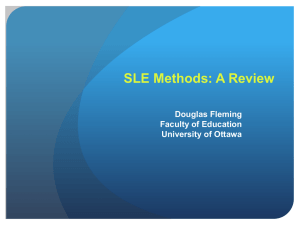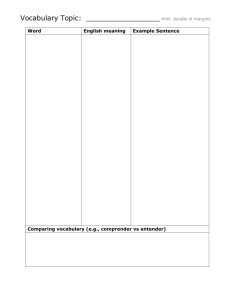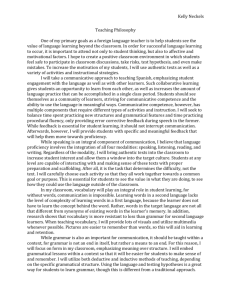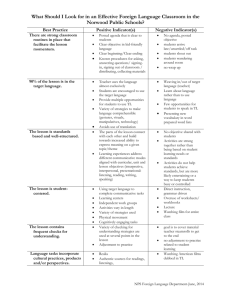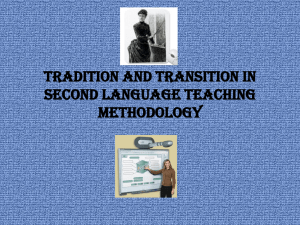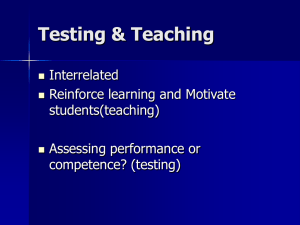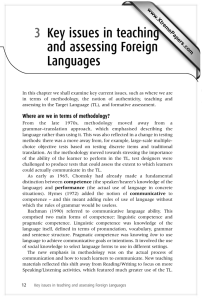File
advertisement
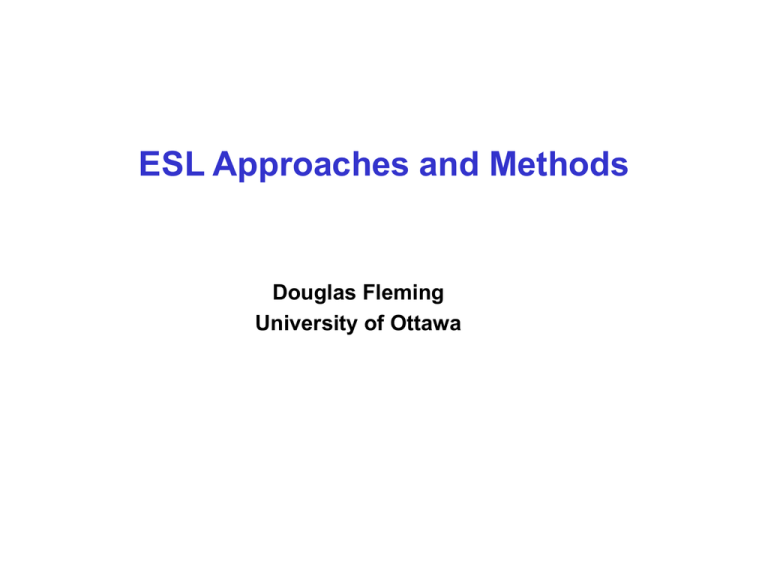
ESL Approaches and Methods Douglas Fleming University of Ottawa Pendulum Swings in the Field “our field has been afflicted with many false dichotomies, weak conceptualizations, and neglect of critical issues and variables” (Carroll, 1965, p. 102) Methods and Approaches • tension between conceptions of teachers as technical implementers of fully developed curricula vs. fully developed professionals • inequalities between SLE theorists and practitioners with methods approaches (Pennycook,1989) • discard simple formulas (Stern, l983) • singular methods are irrelevant to most practice (Nunan, 1991) • Krashen challenged many of the assumptions held within the field The Communicative Approach • the most commonly accepted methodology since the 1980s. • emphasizes the communicative aspect of teaching language, concentrating on function rather than form. As Allen and Widdowson (1979) stated, the approach involves, "the learning of rules of use as well as rules of grammar" (p.141). • The goal is to create a realistic context for language acquisition in the classroom. • The focus is on functional language usage and the ability to learners to express their own ideas, feelings, attitudes, desires and needs. • Open ended questioning and problem-solving activities and exchanges of personal information are commonly utilized. • Students usually negotiate meaning while working with authentic materials (realia) in small groups activities. • Behaviorism forms the basis of the audiolingual approach (which consists mainly of oral drills). The communicative approach assumes that language should be taught in the context of practical communication and use. • Hymes (1966) built on Chomsky’s notion of competence to describe what he called "communicative competence", the ability the people have to communicate (and not merely to know the grammatical structure of the language). This led to Canale and Swain’s highly influential four-part model of language competency: • linguistic: the more purely language elements; structures and grammar • socio-cultural: the social and cultural content and assumptions underlying language use • strategic: what strategies a user of the language utilizes to overcome difficulties or enhance communication • discoursal: what forms of discourse and conventional use is the communication framed in What is the relationship between explicit knowledge of the language and actually using it? Ellis (1997) identified 3 positions in the research: - Strong Interface Position - Non-Interface Position - Weak Interface Position 1) Strong Interface Position (Biaystok, McLaughlin, Sharwood-Smith) • practice turns explicit knowledge of the language directly into implicit knowledge • practice involves supplying the learner with opportunities to produce targeted structures so as to increase implicit knowledge 2) Non-Interface Position (Krashen, Terrell) • there are many cases of acquisition where no learning (formal instruction) occurs • students often cannot produce the structures even though they have excellent explicit knowledge of these structures • even the best learners can only state a limited number of rules, far fewer than the number of structures they can produce • learners benefit from being in the classroom through the use of ‘comprehensive input’ (teacher talk) and by given the opportunity for meaningful practice of the communicative use of language • in normal language use, the learner does not have the time to make use of explicitly understood grammar (at least in oral communication); it is only when the learner can attend to form that explicit grammar knowledge can be put to use 3) Weak Interface Position (Ellis, Long, Selinger) • explicit instruction is a ‘consciousnessraising’ activity the enhances input: 1) for comprehension, helping the learner to intake (recognise and understand features of the input) 2) for explicit knowledge, helping a learner learn about the structure metalinguistically • facilitates ‘noticing’ and ‘noticing the gap’ • helps combine structured syllabi with those that are functional or task based Cognitive Approaches characterized by the belief that language learning is marked by active mental processes and does not occur simply through habit formation Focus on Form • the new trend • "The focus on form approach considers grammar to be heterogeneous, meaning that some grammar points are easy to explain and easy to apply, and other points are difficult if not impossible to apply... • A focus- on form pedagogy profitably mixes explicit and implicit techniques depending on the grammar item and the communicative task” (Kennedy, 2004) • Builds on the Communicative Approach • Is a compromise between the strong and the non-interface positions • Has been developed into structured formulae for the K-7 and Secondary panels such as Balanced Literacy and Smart Learning These approaches all stress the need to distinguish between classroom activities that are either: • Meaning focused That concentrate on purely communicative activities; • Form-focused That draw attention to the way language forms are used in discourse Components of Cognitive Lesson-planning 1) Input: comprehensible models of the target language are provided for learners 2) Central Processing: • Bottom-up processing consists of decoding input. • Top-down processing uses the context of one's learning to ascribe meaning to what has been decoded. 3) Output: 'noticing the gap' between the models of input that have been provided and the output produced Implications for Autonomy and Professionalism • learners: become less dependent on rote learning and more adept at understanding and manipulating linguistic forms in actual communication. • teachers: must exercise professional agency in the interests of a balanced and thoughtful approach to lesson planning and task design
